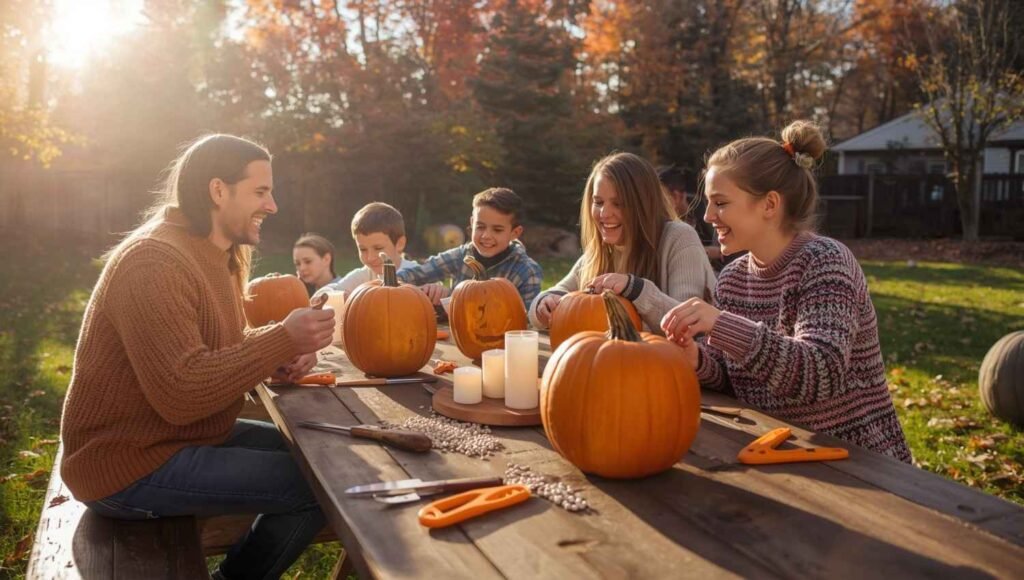The History of the ‘Teal Pumpkin Project’
The Teal Pumpkin Project began as a grassroots effort by one determined mom in East Tennessee named Becky Basalone, who wanted to make Halloween more inclusive for children dealing with food allergies and dietary restrictions. What started as a single teal pumpkin on her porch offering non-food treats and toys soon became an empowering movement for families. Basalone founded the Food Allergy Community of East Tennessee (FACET), encouraging others to join her mission of allergen safety and awareness. The teal color became a symbol of inclusion, empathy, and advocacy for children’s health and Halloween fun.
By 2014, the Food Allergy Research and Education (FARE) organization transformed this local effort into a nationwide initiative, spreading awareness and education about childhood safety and equality during Halloween night. Through this awareness campaign, the project built a supportive community where families could celebrate without fear. The teal pumpkin now stands as a meaningful message of inclusion, tradition, and advocacy, showing that Halloween can be both fun and safe for everyone.
Why is Allergy Awareness Important During Halloween?
Food allergies affect about one in thirteen children, meaning nearly every classroom includes at least one child with dietary restrictions or food allergens that can cause anaphylaxis or other life-threatening reactions. According to the Centers for Disease Control and Prevention (CDC), the best prevention is complete avoidance since there is currently no cure. During Halloween night, when candy is everywhere, raising awareness becomes crucial for public health and children’s well-being. Leslie Young, a pediatrician at MemorialCare Medical Group, highlights that allergy education ensures safety and inclusion, helping avoid an emergency room visit due to a preventable allergic reaction.
Allergy awareness during Halloween activities means creating allergen-free alternatives, non-food options, and a safer environment where every child feels included. From no-peanut rules in schools to community inclusion programs, these awareness programs promote equality for all. By spreading empathy and prevention tips, we help children with food allergies enjoy the same Halloween fun without fear. It’s not just about safety—it’s about raising awareness that leads to understanding and acceptance in every community.
Tips for Neighbors Participating in the ‘Teal Pumpkin Project’
For neighbors who want to participate in the Teal Pumpkin Project, understanding food allergens and ingredient red flags is key to ensuring dietary safety. Experts like David Morris and Harpreet Pall remind us to read labels carefully for hidden allergens like wheat, egg, or peanuts. Even candies such as licorice or candy corn may contain these. Toy safety also matters—avoid moldable clay with wheat or items containing latex, which can trigger allergies. Small toys can pose choking hazards for children under three, so age-appropriate items are crucial.
Consider non-food treats like Smarties, sugar-based candies, or safe alternatives that make Halloween treats fun for everyone. Being part of an inclusive neighborhood means promoting awareness education, risk prevention, and empathy-driven participation. Through local community action, neighbors help create a safe Halloween environment, showing awareness of ingredients and allergen-free gifting practices. It’s a small effort that creates a safety-conscious community where every child can enjoy Halloween night without worry.

Tips for Families Living With Food Allergies on Halloween
For families managing food allergies during Halloween, being proactive makes the night both safe and fun. Parents can embrace the Teal Pumpkin Project by organizing non-food celebrations, like neighborhood parties, games, costume contests, or movie nights, to keep the Halloween spirit alive without relying on candy. Dr. Young suggests that creating food-free Halloween events promotes inclusivity and child safety. For small children, safe treats or non-food activities can still feel special, especially when shared with friends who understand dietary restrictions.
Experts like Dr. Morris emphasize checking labels, avoiding allergens, and encouraging allergy-friendly treat bags to ensure an allergen-free celebration. These food-conscious families help foster understanding and empathy within their community. By spreading awareness and teaching inclusivity, proactive parents create a safe neighborhood where child safety and fun go hand in hand. Collaboration, education, and awareness building ensure every child can enjoy Halloween without fear, proving that thoughtful planning turns challenges into joyful traditions.
DIY Teal Pumpkin Painting for Awareness 🎨
If you want to participate but don’t have a teal pumpkin yet, creating one is easy and fun!
Start with a real or craft pumpkin and paint it teal, the official color of allergy awareness. Use acrylic paint or chalk paint for a smooth finish. Once dry, decorate with stickers, ribbons, or phrases like “Allergy-Friendly Treats Here!” Kids can help by adding glitter, googly eyes, or small foam bats for extra charm.
Place it near your front door or walkway where trick-or-treaters can easily see it. It’s a fun DIY craft that helps raise awareness and spreads kindness throughout your neighborhood.
DIY Halloween Craft: Glow-in-the-Dark Teal Pumpkin 🕯️
Want to make your teal pumpkin stand out at night? Try a glow-in-the-dark craft!
Paint a pumpkin teal first, then layer it with glow paint or LED string lights inside. You can also cut a small heart or star-shaped opening to let light shine through. Add a friendly message like “Safe Treats Inside” using metallic or reflective paint.
This craft not only looks magical but also helps children and parents easily spot allergy-friendly homes. It’s a simple way to combine creativity with compassion.

Hosting an Allergy-Friendly Halloween Event 🎉
Many communities are now hosting allergy-friendly Halloween events where kids can enjoy fun without fear. Plan an outdoor pumpkin hunt, a costume parade, or a craft booth with teal decorations.
Encourage parents to bring non-food items for treat exchanges. Offer temporary tattoos, coloring kits, or bubbles as prizes. These inclusive events create joyful experiences for all kids—those with and without food restrictions—and strengthen neighborhood bonds.
Creative Ways to Spread Awareness in Your Neighborhood 🌈
Spreading awareness about the Teal Pumpkin Project is as simple as starting conversations. Share posts on local Facebook groups or community boards. Encourage friends to join the initiative.
You can also print small cards explaining what the teal pumpkin means and hand them out with treats. Some families even display banners that read, “We Support Allergy-Friendly Halloween!” Awareness grows through these little acts of kindness—and every teal pumpkin adds another voice of inclusion.

How Schools and Teachers Can Support the Teal Pumpkin Project 🏫
Teachers play a big role in promoting inclusion during Halloween celebrations at school. Encourage non-food classroom activities like pumpkin painting, Halloween storytelling, or costume contests.
Schools can also create “safe treat zones” with allergy-free snacks and toys. Teachers can use this opportunity to educate students about empathy, diversity, and why some children can’t eat certain foods. When kids learn early about inclusivity, they carry those values beyond Halloween into everyday life.
🎃 Conclusion
The Teal Pumpkin Project is more than a Halloween trend—it’s a message of compassion, awareness, and inclusion. By painting pumpkins teal, offering non-food treats, or organizing allergy-friendly activities, we help ensure every child can safely experience the magic of Halloween.
Whether you’re a parent, teacher, or neighbor, your small actions—like displaying a teal pumpkin or handing out safe goodies—make a lasting impact. This simple gesture reminds us that Halloween is about community, not candy, and that kindness always shines brighter than fear.
❓ FAQs
Q1: What does a teal pumpkin mean?
A teal pumpkin indicates that the home offers non-food or allergen-free treats to make Halloween safe for children with food allergies.
Q2: Can I buy teal pumpkins instead of painting them?
Yes! Many stores sell pre-painted teal pumpkins, or you can make your own as a fun DIY craft project.
Q3: What are good non-food treats to give out?
Stickers, pencils, glow sticks, small toys, or temporary tattoos are great options for kids of all ages.
Q4: Do I need to sign up to participate in the Teal Pumpkin Project?
No, you don’t need to register. Simply display a teal pumpkin to show your participation and hand out safe treats.
Q5: How can I spread awareness about this project?
Share information online, talk with neighbors, and encourage schools and local communities to support allergy-friendly Halloween celebrations.

